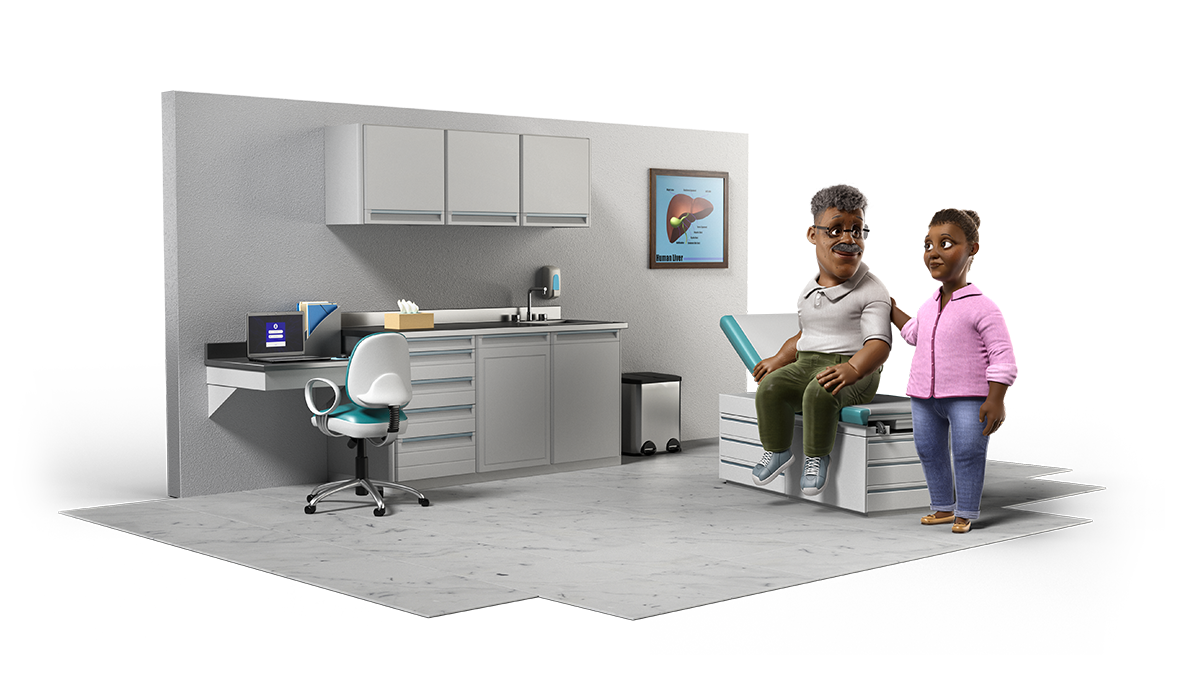Here are a few facts about the liver
The liver is the largest internal organ in the body, and it is located right under your rib cage on the right side
of your body. The liver weighs about 3 pounds and is shaped like a football that has lost
half of its air.
The liver performs many essential jobs that our
bodies depend on every day. Here are some, but
there are many more.
Stores glucose to provide energy
Breaks down fats for better digestion
Helps fight infection and filters the body’s natural
waste products and harmful substances
Helps your body’s immune response
Processes and stores nutrients
Plays an important role in regulating blood volume and the
distribution of fluids in your body
Produces proteins that help stop or prevent bleeding
The liver is responsible for many tasks that are vital to our health, and
that’s why it’s important to understand how it works. Understanding how
the liver works will also help you understand more about the treatment
options your healthcare team suggests.
Remember, when you take good care of your liver, you are
taking important steps to take care of you
Living with HCC: What to expect
Your healthcare team determines the diagnosis of liver cancer based on several factors, including a physical
examination and specific medical tests and procedures:
Diagnosis may include blood tests, ultrasounds, CT scans, and MRIs
Sometimes a procedure called a biopsy is performed. In this instance, a small piece of
liver tissue is removed and looked at under a microscope for cancer cells
Doctors may also do genetic testing of the cancer cells to help determine the best
type of treatment for the patient
After diagnosis, your healthcare team will discuss the diagnosis with you and explain how they evaluated the stage of your
cancer in order to decide which therapies and treatments are appropriate as you move forward. This decision may be based
on the extent of the cancer, your overall health, and possible side effects that you may experience.
Listed below are some of the treatment approaches for liver cancer
Surveillance
Surveillance is for small cancer lesions found during screening that are usually then monitored by a
physician, with a follow-up every three months.
Surgery
Surgical options for liver cancer are either resection (removal of the tumor with surgery) or a liver
transplant. If all of the cancer in the liver is completely removed, that provides the best outlook.
Partial hepatectomy
is surgery to remove only part of the liver. People with good liver function who
are healthy enough for surgery and who have a single tumor that has not grown into blood vessels
can have this operation.
Ablation
Ablation is treatment that destroys liver tumors without removing them. This procedure can be used in
patients with a few small tumors and when surgery is not a good option (often because of poor health or
reduced liver function)
Radiofrequency ablation
uses a high-frequency electric current to kill tumor cells. External-beam
radiation therapy uses high-energy X-rays to kill tumor cells.
Radiation therapy
Radiation therapy uses high-energy rays (or particles) to kill cancer cells. It may not be a good option for
some patients whose liver has been greatly damaged by diseases such as hepatitis or cirrhosis.
Embolization
Embolization is a procedure that injects substances directly into an artery in the liver to block or
reduce the blood flow to a tumor in the liver. Here are three types of this approach:
Trans-arterial chemoembolization (TACE)
is usually the first type of embolization used for large liver
cancers that cannot be treated with surgery or ablation. It combines embolization with
chemotherapy (chemo). Most often, this is done by giving chemotherapy through the catheter.
Drug-eluting bead chemoembolization (DEB-TACE)
combines TACE embolization with drug-eluting
beads (tiny beads that contain a chemotherapy drug). The procedure is essentially the same as
TACE except that the artery is blocked after drug-eluting beads are injected.
Radioembolization
combines embolization with radiation therapy. This is done by injecting small
beads (called microspheres) into the hepatic artery. These microspheres have a radioactive
isotope (yttrium-90 or Y-90) attached to them.
Chemotherapy (chemo) Chemotherapy refers to a type of medicine that causes rapidly dividing cells, like cancer cells, to die.
Immunotherapy Immunotherapy is the use of medicines that help a person’s own immune system find and destroy cancer cells.
Targeted therapies Targeted therapy is a type of cancer treatment that targets proteins either from inside or outside of the cancer cells to control how they grow, divide, and spread.
Tyrosine kinase inhibitors (TKIs) are small-molecule drugs that go through the cell membrane and work inside cancer cells to block signals that cancer cells need to grow and divide.
Monoclonal antibodies (mAbs) are man-made versions of immune system proteins (antibodies) that are designed to recognize and attach to a specific target protein outside of the cancer cell, usually on its surface.
Supportive (palliative) care
Supportive care for people with cancer can include relieving side effects and symptoms of the disease
and its treatments, and may also include medication, nutritional changes, relaxation techniques, and
emotional support.
Blue Faery: The Adrienne Wilson Liver Cancer Association offers many useful free resources. Blue Faery’s Patient
Resource Guide for Liver Cancer provides information and answers to frequently asked questions about liver
cancer. Download the English or Spanish version.






